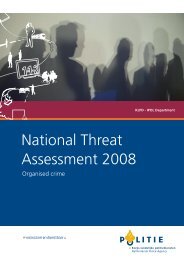Assessing the Effectiveness of Organized Crime Control Strategies ...
Assessing the Effectiveness of Organized Crime Control Strategies ...
Assessing the Effectiveness of Organized Crime Control Strategies ...
You also want an ePaper? Increase the reach of your titles
YUMPU automatically turns print PDFs into web optimized ePapers that Google loves.
<strong>Assessing</strong> <strong>the</strong> <strong>Effectiveness</strong> <strong>of</strong> <strong>Organized</strong> <strong>Crime</strong> <strong>Control</strong> <strong>Strategies</strong>:<br />
A Review <strong>of</strong> <strong>the</strong> Literature<br />
exercised here again, however, due to <strong>the</strong> tendency <strong>of</strong> <strong>the</strong>se accounts to be sensationalistic and<br />
speculative. Fur<strong>the</strong>rmore, journalistic works tend to focus more on OC figures and <strong>the</strong>ir<br />
activities, than on <strong>the</strong> effectiveness <strong>of</strong> control strategies.<br />
3.3 Crude and Varied Performance Measures<br />
A variety <strong>of</strong> measures have been proposed in assessing <strong>the</strong> impact <strong>of</strong> OC control strategies<br />
(Peterson, 1994:381; Maltz, 1990). A study may, <strong>of</strong> course, adopt several measures. Some <strong>of</strong><br />
<strong>the</strong> key measures used or proposed have been:<br />
• Body-count measures (e.g., <strong>the</strong> number and nature <strong>of</strong> cases opened, arrests, prosecutions,<br />
convictions, and prison terms imposed);<br />
• Size <strong>of</strong> <strong>the</strong> illicit market (e.g., changes in <strong>the</strong> volume <strong>of</strong> drugs trafficked/sold, number <strong>of</strong><br />
usurious loans);<br />
• Volume and scope <strong>of</strong> organized crime groups (e.g., <strong>the</strong> impact <strong>of</strong> control efforts on<br />
criminal organizations or <strong>the</strong>ir leadership);<br />
• Efficiency <strong>of</strong> criminal justice units (e.g., strike forces);<br />
• Harms produced by OC (e.g., <strong>the</strong> impact <strong>of</strong> control efforts on <strong>the</strong> physical, economic, and<br />
o<strong>the</strong>r harms occasioned by OC);<br />
• Seized and forfeited assets and recovery <strong>of</strong> unpaid taxes.<br />
Body-Count Measures<br />
Among <strong>the</strong> most common measures <strong>of</strong> <strong>the</strong> impact <strong>of</strong> OC control strategies are tallies <strong>of</strong> arrests<br />
and convictions achieved. The Canadian Association <strong>of</strong> Chiefs <strong>of</strong> Police (1993) for example,<br />
provide a breakdown, by province, <strong>of</strong> <strong>the</strong> number <strong>of</strong> charges and arrests for various activities in<br />
which criminal organizations are thought to be involved. However, such reports provide no<br />
indication as to <strong>the</strong> proportion <strong>of</strong> acts <strong>of</strong> prostitution, illicit gambling, drug trafficking, and<br />
related activity that are linked to OC. Also, police data <strong>of</strong> this kind tend to seriously<br />
underestimate <strong>the</strong> volume <strong>of</strong> such activities, as <strong>the</strong>re is a massive “dark figure” in relation to<br />
consensual crimes, extortion, and many o<strong>the</strong>r activities associated with OC.<br />
Fur<strong>the</strong>rmore, simple body-counts <strong>of</strong> this type provide no indication <strong>of</strong> <strong>the</strong> justice system inputs<br />
required to generate <strong>the</strong>m (i.e., no cost-benefit analysis) and no information on <strong>the</strong> impact <strong>of</strong> <strong>the</strong><br />
law enforcement activity on <strong>the</strong> relevant criminal organizations. Maltz (1990:39) argues that<br />
counting convictions and computing average sentence lengths is tantamount to determining <strong>the</strong><br />
battles won with no indication <strong>of</strong> how <strong>the</strong> war is going. Since all convictions are given <strong>the</strong> same<br />
weight, such data provide no information on <strong>the</strong> significance <strong>of</strong> <strong>the</strong> battles won. A strike force<br />
can conceivably run up an impressive tally <strong>of</strong> convictions by pursuing <strong>the</strong> easiest cases. In some<br />
contexts, this may even assist more powerful criminal organizations, as more vulnerable<br />
competitors are put out <strong>of</strong> circulation.<br />
Moreover, what is one to make <strong>of</strong> a reduction in <strong>the</strong> number <strong>of</strong> charges following <strong>the</strong><br />
introduction <strong>of</strong> a new enforcement initiative Is such a reduction an indication <strong>of</strong> failure or an<br />
indication <strong>of</strong> <strong>the</strong> deterrent effect <strong>of</strong> <strong>the</strong> new measures (Marx, 1988:109) Many police reports<br />
trumpeting a large arrest tally, or <strong>the</strong> conviction <strong>of</strong> some high pr<strong>of</strong>ile <strong>of</strong>fenders, imply that more<br />
12 | Research and Statistics Division / Department <strong>of</strong> Justice Canada








